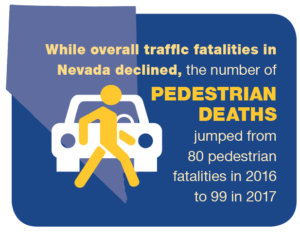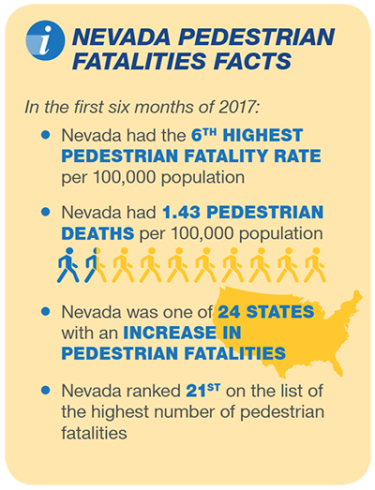The Governors Highway Safety Association’s (GHSA) annual “Spotlight on Pedestrian Traffic Fatalities” takes a look at pedestrian fatalities, which have grown significantly faster than other traffic-related deaths in recent years. The report examines pedestrian fatality data by state from the first half of 2017 and explores factors contributing to the increase in pedestrian fatalities.
It is estimated that 5,984 pedestrians were killed nationally in motor vehicle crashes in 2017, and an estimated 5,987 pedestrians killed in 2016. However, over the last ten years, pedestrian fatalities are on the rise, increasing 27% from 2007 to 2016. Meanwhile, all other traffic-related deaths decreased by 14%. In 2016, pedestrians accounted for 16% of all traffic fatalities. The U.S. has not seen such a high percentage of pedestrian fatalities since 1983.
is estimated that 5,984 pedestrians were killed nationally in motor vehicle crashes in 2017, and an estimated 5,987 pedestrians killed in 2016. However, over the last ten years, pedestrian fatalities are on the rise, increasing 27% from 2007 to 2016. Meanwhile, all other traffic-related deaths decreased by 14%. In 2016, pedestrians accounted for 16% of all traffic fatalities. The U.S. has not seen such a high percentage of pedestrian fatalities since 1983.
Many factors contribute to pedestrian fatalities. For example, in 2016, 75% of pedestrian fatalities in 2016 occurred after dark, 33% occurred when the pedestrian had a Blood Alcohol Concentration (BAC) of 0.08 grams per deciliter (g/dL) or higher, and 13% occurred when the driver had a BAC of 0.08 g/dL or higher. Other environmental factors such as lack of pedestrian facilities (sidewalks, crosswalks, traffic signals, or pedestrian overpasses/underpasses), lack of pedestrian visibility, and higher vehicle speeds may also contribute to pedestrian fatal pedestrian crashes.

Two additional potential factors are the legalization of recreational marijuana and increasing smartphone use. Nevada, six other states (Alaska, Colorado, Maine, Massachusetts, Oregon, and Washington), and Washington, D.C. legalized recreational marijuana from 2012-2016. They saw a collective 16.4% increase in pedestrian fatalities in the first half of 2017, compared to the other states that saw a collective 5.8% decrease in pedestrian fatalities. Nevada legalized recreational marijuana in 2016 and reported a 19.4% increase in pedestrian fatalities in the first half of 2017, as compared to the first half of 2016. While recreational marijuana cannot be stated as the cause of this increase, it could be a potential factor since marijuana can impair judgment and reaction time of both pedestrians and motorists.
So what is Nevada doing to reduce pedestrian fatalities?
First, we are engineering pedestrian improvement projects across the state, adding lighting, crosswalks, and sidewalks to improve pedestrian safety. NDOT has set aside $10M each year for pedestrian safety improvements. Second, law enforcement agencies are committed to increased enforcement, and lastly, our ePEDemic campaign tells the stories of pedestrians killed on Nevada roads to increase awareness of pedestrian safety. View the GHSA Spotlight on Pedestrian Traffic Fatalities online here.
Facts courtesy of:
GHSA, Pedestrian Traffic Fatalities by State: 2017 Preliminary Data
NDOT, Nevada Pedestrian Fatalities Rise in 2017 While Overall Traffic Fatalities Decline

